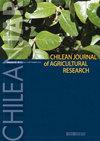补光量和生长季节影响生菜品质和抗氧化活性
IF 1.8
4区 农林科学
Q2 AGRICULTURE, MULTIDISCIPLINARY
引用次数: 0
摘要
光谱在调节植物生长发育、影响光合作用和光形态发生中起着重要作用。目的是评价不同季节温室环境光补充下不同红蓝比(R:B) LED灯照射下的莴苣(Lactuca sativa L. var. capitata L.)植株的重量和抗氧化活性。采用5个LED光补充处理,白光(W)作为对照,蓝:绿:红:远红(B:G:R:Fr)比例= 30:45:20:5;0.7:1.0),蓝色(B = 50:20:20:10;R:B = 0.4:1.0), white-r (Wr = 25:30:40:5;1.6:1.0), white-R (WR = 15:15:63:7;4.2:1.0)和红色(R = 10:10:75:5;7.5:1.0),分别在初秋、深秋和冬季施用。移栽入水培系统后,具有3-4片真叶(根长5-6 cm)的生菜植株立即进行光处理14 d后收获。初秋、深秋和冬季,环境光和补充光的PAR范围分别为361 ~ 495,222 ~ 304和297 ~ 407 µmol m-2 s-1。生菜鲜叶质量在初秋高于深秋和冬季,因为叶片数最多。在初秋,光处理中只有最高R:B(7.5:1.0)处理的莴苣质量较低。总体而言,添加R:B在1.6 (Wr) ~ 4.2 (Wr)之间的生菜DM显著高于对照(0.7:1.0)。总酚含量(TPC)和抗氧化能力(AC)在初秋最高,其次是冬季和深秋。最高R:B(7.5:1.0)的光照在整个生长季均降低了TPC和AC。本研究表明,在R:B为1.6 ~ 4.2的条件下,初秋生长的本文章由计算机程序翻译,如有差异,请以英文原文为准。
Light supplementation and growing season affect the quality and antioxidant activity of lettuce
The light spectrum plays a major role in regulating plant growth and development, influencing photosynthesis and photo-morphogenesis. The objective was to evaluate the weight and antioxidant activity of âLaviniaâ lettuce (Lactuca sativa L. var. capitata L.) plants under LED lights with different red:blue ratios (R:B) used as a supplement to ambient light in a greenhouse at different seasons. Five LED light supplemented treatments were used, white (W, as control, ratio blue:green:red:far-red (B:G:R:Fr) = 30:45:20:5; 0.7:1.0), blue (B = 50:20:20:10; R:B = 0.4:1.0), white-r (Wr = 25:30:40:5; 1.6:1.0), white-R (WR = 15:15:63:7; 4.2:1.0) and red (R = 10:10:75:5; 7.5:1.0) were applied in early autumn, late autumn and winter. Immediately after transplant into the hydroponic system, lettuces plants with 3-4 true leaves (5-6 cm root length) were treated with light treatments for 14 d and harvested. In early autumn, late autumn, and winter, the PAR range applied in ambient light and supplemental lights was between 361 to 495, 222 to 304, and 297 to 407 µmol m-2 s-1, respectively. Lettuce showed the highest fresh leaf mass in early autumn compared to late autumn and winter due to the highest leaf number. In early autumn, only lettuce under the highest R:B (7.5:1.0) had a lower weight among the light treatments. Overall, lettuces supplemented with R:B between 1.6 (Wr) to 4.2 (WR) had significantly higher DM than the control (0.7:1.0). Total phenolic contents (TPC) and antioxidant capacity (AC) were highest in early autumn, followed by winter and late autumn. Light with the highest R:B (7.5:1.0) diminished TPC and AC in all growing season. This study showed that the quality of âLaviniaâ lettuce plants grown in early autumn under R:B between 1.6 and 4.2 improved DM, and higher red component decreased the antioxidant activity.
求助全文
通过发布文献求助,成功后即可免费获取论文全文。
去求助
来源期刊

Chilean Journal of Agricultural Research
AGRICULTURE, MULTIDISCIPLINARY-AGRONOMY
CiteScore
3.10
自引率
11.80%
发文量
60
审稿时长
6-12 weeks
期刊介绍:
ChileanJAR publishes original Research Articles, Scientific Notes and Reviews of agriculture, multidisciplinary and agronomy: plant production, plant protection, genetic resources and biotechnology, water management, soil sciences, environment, agricultural economics, and animal production (focused in ruminant feeding). The editorial process is a double-blind peer reviewing, Editorial Office checks format, composition, and completeness, which is a requirement to continue the editorial process. Editorial Committee and Reviewers evaluate relevance and scientific merit of manuscript.
 求助内容:
求助内容: 应助结果提醒方式:
应助结果提醒方式:


